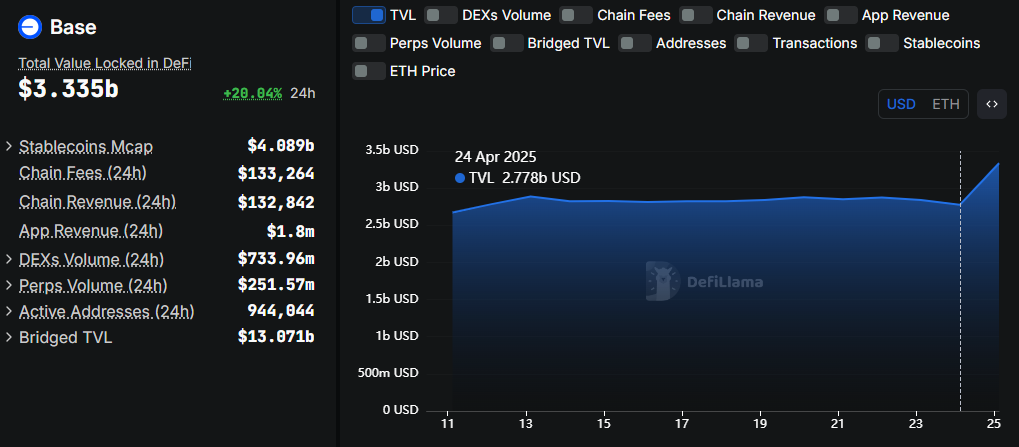-
Base blockchain sees a 20% surge in TVL, rising by $557 million to $3.335 billion following Binance.US integration for ETH and USDC transfers.
-
Binance.US now supports deposits and withdrawals via Base, enabling faster and cheaper transactions compared to Ethereum’s mainnet.
-
Base’s rise in TVL reflects increased user activity and trust, following Binance.US’s support for Ethereum and USDC on its Layer-2 network.
Base’s Total Value Locked surges 20% as Binance.US integration boosts ETH and USDC transfers, signaling rising user trust and adoption.
Base TVL Soars 20% As Binance.US Adds Support
According to data on DefiLlama, Base TVL is up by $557 million, moving from $2.778 billion on Thursday to $3.335 billion as of this writing, marking a 20% surge in just 24 hours.

Base TVL. Source: DefiLlama
The surge in TVL suggests an increased volume of assets staked, locked, or deposited in the Base blockchain. A higher TVL indicates increased user activity, trust, and adoption, with users committing capital to the protocol.
Meanwhile, this surge follows a notable announcement from Binance.US, the American arm of Binance exchange, the world’s largest crypto trading platform by volume metrics.
According to the announcement, Binance.US now supports Base, allowing for Ethereum (ETH) and Circle’s USDC (USD Coin) stablecoin transfers on the Layer-2 network.
“We’re excited to announce that Binance.US now supports Base! Starting today, you can deposit and withdraw Ethereum (ETH) and USDC via Base,” an excerpt in the announcement read.
The exchange highlighted that more assets will join Binance.US on the Base network, indicating interest in developing the integration. Utilizing Base’s blockchain, users can now deposit and withdraw ETH and USDC directly to and from Binance.US.
For the exchange, this integration could bolster accessibility. Specifically, Binance.US users can interact with Base’s ecosystem without bridging assets through Ethereum’s mainnet. This comes amid concerns regarding Ethereum’s mainnet, which is often seen as slow and costly.
As an L2 scaling solution, Base offers faster and lower-cost transactions compared to Ethereum’s mainnet. Data on Etherscan shows Ethereum’s transaction throughput is approximately 13.2 TPS, which could lead to network congestion and high gas fees during peak periods.

Ethereum TPS. Source: Etherscan
On the other hand, Base processes transactions off-chain, bundling them before submitting them to Ethereum. This method achieves higher throughput and significantly lower fees, making it more cost-effective for users.
Therefore, the integration allows Binance.US users to move ETH and USDC to Base for DeFi activities at a fraction of the cost.
This development comes only months after Binance.US restarted USD deposits and withdrawals via bank transfer following a two-year hiatus.
Binance.US suspended its USD deposit and withdrawal services following a high-profile SEC lawsuit and mounting regulatory pressure beginning in 2023. However, amid shifting political rhetoric toward crypto, exchanges appear to be taking bold steps.
“Now that we’ve survived, our goal is to help crypto thrive and empower all Americans with freedom of choice,” Binance.US interim CEO Norman Reed stated recently.
This aligns with a recent move from the Kraken exchange, which listed BNB, marking a strategic shift in US crypto exchanges and potentially signaling broader token adoption in the country.
Conclusion
The recent surge in Base’s TVL, propelled by Binance.US’s support for ETH and USDC, highlights a significant shift in the crypto landscape, presenting new opportunities for users. As regulatory narratives evolve, the integration cements Base’s role as a critical player in the crypto ecosystem. With continued advancements, Base is likely to remain a focal point for DeFi participants seeking lower fees and enhanced transaction speeds.
